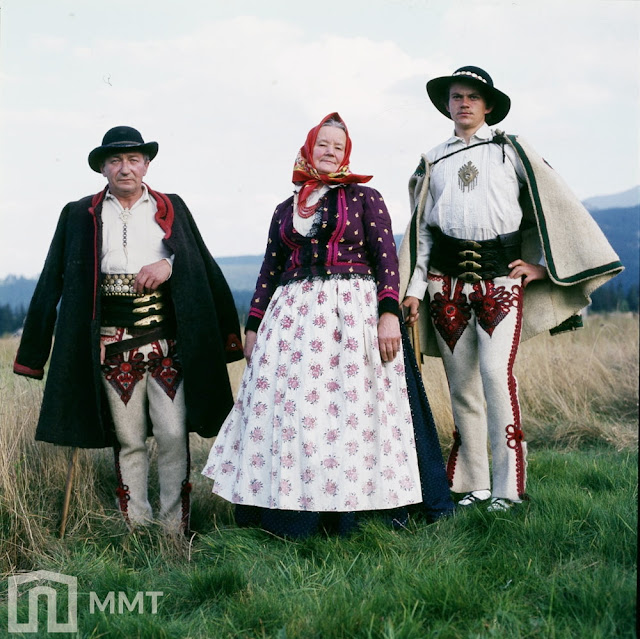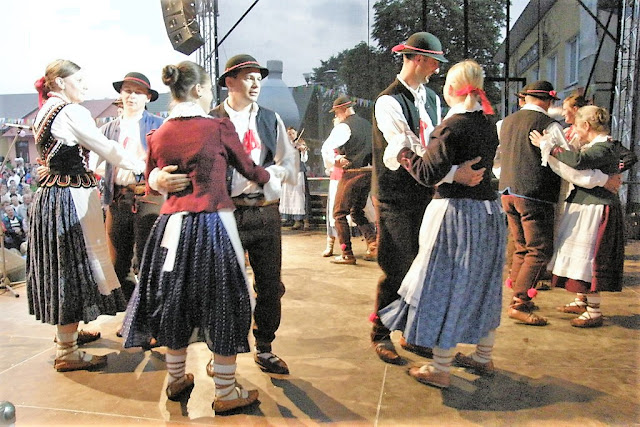Hello all,
Today I will continue my article on the Folk costumes of Poland according to the present borders.
Here again is the map of the traditional regions of Poland.
Today I will focus on Malopolska, in bluish gray on the map,as well as the two small enclaves of Orawa and Spisz in the south which were technically separate, being part of the Hungarian Empire.
Malopolska or Lesser Poland
The 'lesser' here refers to the heart of Poland, as opposed to 'greater', which refers to areas settled later on or on the perifery, as in 'the greater Chicago area'. The cultural center of both Malopolska and Poland is Krakow. I will here follow the old definition of this region as shown in the map above. I will move roughly from west to east.
The costumes of northwestern Malopolska resemble those of Mazowsze.
This region lies between Upper Silesia and Wielun' Land. You can see it on the map as an arm of Malopolska on the west.
https://en.wikipedia.org/wiki/Cz%C4%99stochowa
Opoczno
This region lies east of Piotrkow and south of Rawa Mazowiecka in northwestern Malopolska. The costume resembles both of theirs, but is better known than either. The embroidery of this region is justly famous.
https://en.wikipedia.org/wiki/Opoczno
Radom
This region lies east of Opoczno and directly south of Warsaw.
https://en.wikipedia.org/wiki/Radom
Kielce
Kielce is south of a midpoint between Opoczno and Radom.
https://en.wikipedia.org/wiki/Kielce
The Holy Cross region is an isolated mountain range a bit south and east of Kielce. Kielce is often considered to be the capitol of this area.
Świętokrzyskie
Kraków
This is a large region, southwest of Kielce, and directly south of Opoczno. The city has long been the cultural capitol of Poland, and the Krakow folk costume is often considered to symbolize Poland as a whole. There are many local variants of the costume, but they are usually grouped into the eastern variants, and the western. I will show just two famous versions.
https://en.wikipedia.org/wiki/Krak%C3%B3w
https://en.wikipedia.org/wiki/Krakowiacy
https://en.wikipedia.org/wiki/Zalipie,_Lesser_Poland_Voivodeship
West Krakowiak - Bronowice
https://en.wikipedia.org/wiki/Bronowice_(Krak%C3%B3w)
Zagłębie Dąbrowskie
This region is west of the Krakowiaki, next to Upper Silesia. It is marked in the map at the head of the article. There are two costumes from this region, one which resembles Mazowsze costumes, and one which more resembles Silesian ones.
Zagłębie Dąbrowskie
The southernmost region, between Krakow and Slovakia, is extremely rich in costumes and folklore.
Wilamowice
This costume comes from one village which was settled by Flemish, Frisian and Scots in the middle ages. I have written an article on this costume. It is found southwest of the Krakow region.
https://en.wikipedia.org/wiki/Wilamowice
https://folkcostume.blogspot.com/2019/03/costume-and-embroidery-of-wymysorys-or.html
Żywiec
This town is south of Wilamowice, and has developed a town costume which is very elaborate and has been much influenced by aristocratic costume. I have also written an article on this costume.
https://en.wikipedia.org/wiki/%C5%BBywiec
https://folkcostume.blogspot.com/2016/10/town-costume-and-embroidery-of-zywiec.html
South and east of Zywiec live the Highlanders, or Gorals. They occupy most of the territory from the Krakow region to the Slovak border and beyond. They consider themselves to be distinct from the rest of the Polish.
https://en.wikipedia.org/wiki/Gorals
They form over a dozen groups, each with their own territory and costume. I have already written an overview article on the Gorals.
https://folkcostume.blogspot.com/2018/08/overview-of-folk-costumes-of-gorale.html
Here is a map of the distribution of the various Goral groups. In this article I will only show the groups that lie within the current borders of Poland.
Górale śląscy - Silesian Gorals
These people are represented by the orange area at the left of the map, being found south of Cieszyn on both the Polish and Moravian sides. This territory is technically Silesia, but they are tight up against the border, and part of this larger group.
https://en.wikipedia.org/wiki/Silesian_Gorals
Górale żywieccy - Żywiec Gorals
This group is represented by purple on the map above. They live south of the town of Zywiec.
https://pl.wikipedia.org/wiki/G%C3%B3rale_%C5%BCywieccyGórale Orawce - Orava Gorals
These people are represented by light red on the map above. They live on both sides of the border, the Polish side being to the east of the Slovak side. This forms the northernmost part of the former Árva County of the Hungarian Empire. This is in purple on the map at the head of the article, not being technically part of Malopolska.
https://en.wikipedia.org/wiki/Orava_(region)
Górale babiogórscy - Gorals of Babia Góra
These people are represented by lavender in the center of the map above. They live to the north of Babia Góra, or Witches Mountain, on the Slovak Polish border.https://en.wikipedia.org/wiki/Babia_G%C3%B3ra
Górale Kliszczacy - Klishchatsy Gorals
This is one of the lesser known groups, shown in orange in the upper center of the Goral map above.
https://pl.wikipedia.org/wiki/G%C3%B3rale_Kliszczaccy#Kultura_Kliszczak%C3%B3w_w_XX_i_XXI_wieku
Górale zagórzańscy - Transmontane Gorals
This group is represented in pink on the map above, just north of the Podhale region.
They live east of the Kliszczacy, and south of the lowland groups known as Lachy.
https://pl.wikipedia.org/wiki/Zag%C3%B3rzanie
Górale podhalańscy - Podhale Gorals
This is by far the best known group. They are shown on the map in khakhi green. They live mostly in Poland, in the High Tatras, the main town being Nowy Targ, but also inhabit a small corner of Slovakia called Sucha Gora [Suchá Hora].
https://pl.wikipedia.org/wiki/Sucha_G%C3%B3ra_(S%C5%82owacja)
Górale spiscy - Spiš Gorals
This group is shown in dark red in the lower right of the map above. A small part of this region is in Poland, and a larger part in Slovakia. There are two Goral costumes in the Polish part of this region. This area was also originally part of the Hungarian empire rather than Malopolska, being shown in fuchsia in the map at the head of the article.
https://pl.wikipedia.org/wiki/Spiszacy
Jurgów
https://en.wikipedia.org/wiki/Jurg%C3%B3w
Kacwin and Trybsz
This group is also shown in orange on the map above, to the right. They live to the east of the Zagorzanie, and northeast of the Podhalane. You can see that they form two separate enclaves, which have two different costumes: the Górale Łąccy or White Gorals in the west, and the Górale nadpopradzcy, or Black Gorals in the east. The general name indicates that they live south of the region of Sącz.
https://pl.wikipedia.org/wiki/G%C3%B3rale_s%C4%85deccy
Górale Łąccy
https://pl.wikipedia.org/wiki/G%C3%B3rale_%C5%82%C4%85ccy
Górale Pienińscy or Szczawnickimi - Pieniny or Szczawnica Gorals.
This group is represented by blue to the right of the map above. They also live over the border in Slovakia, in and around the villages of Červený Kláštor and Spišská Stará Ves.
The Szlachtowa Lemkos, who lived just east of them, shown in khaki on the map, wore essentially the same costume. I have previously written a more in depth article on this costume.
https://pl.wikipedia.org/wiki/G%C3%B3rale_pieni%C5%84scy
This group lives on the Polish Slovak border surrounded on the west, east, and south by Lemko / Rusyns. They live in the villages of Pilhov and Mníšek nad Popradom in Slovakia just over the border as well. To the north lie the Lachy of Sącz and the Pogorzanie. They are also called Black Gorals because unlike all other Gorals, the men wear black or dark brown wool pants.
https://pl.wikipedia.org/wiki/Czarni_G%C3%B3rale
East of this area and south of the Krakow region but north of the highlanders, live a group known as the Lachy. They have four different costumes. I have already written an article about these.
https://folkcostume.blogspot.com/2019/02/folk-costume-of-lachy-part-1-overview.html
Lachy Szczyrzyckie
This group lives north of the Zagorzanie and south of the Krakowiaki.
https://en.wikipedia.org/wiki/Szczyrzyc
Lachy Limanowskie
This group lives to the southeast of the Szczyrzyckie.
https://en.wikipedia.org/wiki/Limanowa
Lachy Sądeckie
This region lies south of Krakow and north of the Gorals, around the twin cities of Sącz. There are two costumes in this region.
https://en.wikipedia.org/wiki/Lachy_S%C4%85deckie
Podegrodzie area, in the south, close to the Gorals.
This group lives east of Sącz and north of the Lemkos, in the southeast corner of Malopolska. The costume shows significant influence from the south, of the Lemkos and Slovaks.
https://en.wikipedia.org/wiki/Polish_Uplanders
Krosno
This is part of the Pogorzan region. The current costume has been reconstructed with zigzag lines of ribbon on the aprons and sometimes skirts. It is likely that it was based on an old drawing, and the zigzag lines were actually cutwork, but were made insufficiently distinct in the drawing. It is extremely unlikely that ribbons were traditionally applied in such a manner. Krosno was bordered on both south and north by Lemko people. There were colonies of Germans in this area, as well, called Głuszoniemcy.
https://en.wikipedia.org/wiki/Krosno
Lasowiacy
The Lasowiacy lived north of the Pogorzanie, between the confluence of the Vistula and San rivers in the east of Malopolska. The costume is an older one, based mostly on white linen, with little addition of the addition of commercial cloth so typical of some of the surrounding regions.
https://en.wikipedia.org/wiki/Lasowiacy
Sandomierz
This lies southeast of the Holy Cross mountains and north of the Lasowicy in the east of Malopolska.
https://en.wikipedia.org/wiki/Sandomierz
Lublin Land
Powisle Lubelski
This region lies in the southwest of Lublin district, along the Vistula.
https://pl.wikipedia.org/wiki/Powi%C5%9Ble_Lubelskie
Pulawy - Ryki - Stężyca
This region lies in the northwest of Lublin district, and also lies along the Wisla.
https://en.wikipedia.org/wiki/Pu%C5%82awy
Krzczonów
This region lies in south central Lublin district. This costume is often presented as the Lublin Costume.
https://en.wikipedia.org/wiki/Krzczon%C3%B3w,_Lublin_Voivodeship
Lubartów
This region lies in north central Lublin district.
https://en.wikipedia.org/wiki/Lubart%C3%B3w
Łuków Land
This area lies even further north, in the corner of Malopolska with Mazowsze, Podlasie and Polesie. The costume is poorly remembered, and resembles that of Lubartow and Pulawy.
https://en.wikipedia.org/wiki/%C5%81uk%C3%B3w_County
That is plenty for one article. I will continue with Czerwona Rus and Lemko Land in the next article.
Thank you for reading, I hope that you have found this to be interesting and informative.
Roman K.
email: rkozakand@aol.com


















































































































This comment has been removed by the author.
ReplyDeleteGran trabajo..........felicidades!!!!!!!!!!!!!!
ReplyDeleteThis was so interesting! I only wish there were more from North Eastern Poland. But I still enjoyed it.
ReplyDeleteExploring folklore traditions in education enriches cultural understanding and fosters creativity. When students buy narrative essay samples on this topic, they gain insights into effective storytelling and academic structure. These essays can guide learners in connecting traditional tales with modern educational themes, encouraging deeper engagement with heritage and learning. It's a valuable resource for developing strong, meaningful narratives.
ReplyDelete